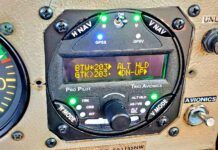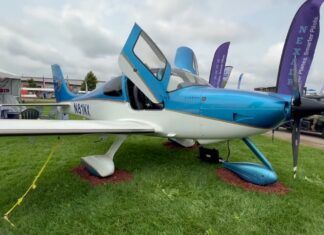What with the market flush with panel-mount GPS navigators, now comes another twist to cloud the avionics upgrade decision: At the 11th hour, loran has dodged the budget bullet and will remain on the air at least for the next decade.
In mid-summer, the Department of Transportation announced that it has reversed its decision to pull the plug on loran in the year 2000 and will keep the system alive until 2008. (Actually, the official decision hadnt been announced in early August but DOT leaked the information to aviation and marine user groups.)
Thats good news, right? Especially if youve got an old Apollo or Foster loran steaming along in the panel and just cant bring yourself to sign over a $6000 check to your avionics guy for a new IFR GPS. After all, the loran works as we’ll as it ever did and if you had the wisdom to certify it for IFR, youve got legal area navigation we’ll into the millennium.
Besides, the thing aint worth squat on the used market. Lorans that cost five grand new are gathering dust in used parts bins and we wouldnt be surprised if you could latch onto one merely for the asking.
But the other side to the loran extension coin is that the avionics industry planned to be done with loran in two years, having moved foursquare toward the true future of air navigation: GPS. The specter of old Apollos and Northstar M-1s soldiering into the sunset gives avionics marketing directors a killer case of acid reflux.
Then there’s the GPS back-up issue. Last winter, in the face of troubling and thus far unresolved technical shortcomings in GPS, the FAA admitted that, well, yes, maybe GPS would need some sort of back-up system. And there on the short list to step into the breach was loran-C.
Cheaper to Keep
The official government roadmap of navaids-the Federal Radionavigation Plan-first called for the decommissioning of loran-C in 1994 and gave the year 2000 as the official date. At the time, GPS had been declared operationally capable, even though IFR-certified receivers were only then coming onto the market.
Predictably, the effect on the loran market was all but instantaneous. Demand fell sharply and, just as important, the avionics manufacturers diverted their limited R&D dollars to GPS. Yet even though the market wasnt interested in new loran, it certainly was committed to keeping the units already installed perking along.
AOPA and other user groups lobbied vigorously to convince DOT to change its mind on loran. At Oshkosh in 1994, the loran association sponsored a petition drive and evidently stirred up interest among thousands of loran owners.
In response-and by Congressional mandate-DOT hired the high-powered consulting firm of Booze-Allen & Hamilton to examine the loran program to determine once and for all if the user clamor was a bonafide economic burden or merely special interest turf protection.
Although the details hadnt been released by late July, the consultant reportedly found it would cost $764 million to shutdown loran in 2000, with $315 million paid by owners to remove and replace obsolete navigators and $100 million to dismantle the system. Booze-Allen found that operating loran until the year 2015 would cost about $473 million, including upgrades to the loran chains, maintenance and operation.
A DOT official told us privately that Booze-Allens initial numbers are likely to be wide of the mark and will be adjusted downward but the basic conclusion still stands: Its cheaper to keep loran in place than to shut it down. Were told that in the halls of FAA and DOT, continuance is considered a done deal.
Still a Cloudy Future
But thus far, none of this means loran is back in the game for the long haul. It could very we’ll be that five years from now-or even sooner-newly upgraded loran stations will be broadcasting their nav signal across the land with few pilots listening.
Estimates of how many aviation lorans remain in the fleet vary between 50,000 and 70,000 but theyre slowly being replaced by GPS, even though IFR-approved satnav is found in only a fraction of the GA fleet thus far.
DOT shot itself in the foot with what may turn out to be a premature announcement to dump loran in 1994. The effect on the loran market was immediate and dramatic but rather than nudging owners toward purchasing GPS, as the DOT had hoped, most owners have adopted a wait-and-see attitude, keeping their old lorans or buying a sophisticated portable GPS with features even the best lorans couldnt match.
The FAAs grand plan to convert to satellite navigation sometime after the turn of the century is dependent on owners embracing GPS enthusiastically, not to mention quickly.
Ironically, the loran extension may give owners yet more excuses not to buy panel-mount GPS, further aggravating the equipage issue that the FAA considers so critical. Lorans long-term future depends almost entirely on whether the FAA considers it to be a serious back-up for GPS and says as much by official decree. As the Booze-Allen report was being prepared, the FAA was conducting its own research project to pin down just how reliable GPS really is, with an eye toward recommending a back-up system.
As we went to press in early August, the FAA had just hired Johns Hopkins Applied Physics Laboratory to conduct the risk assessment.
Recent incidents of unintentional jamming have been widely publicized and although the agency is forging ahead with its Wide Area Augmentation System (WAAS) for GPS, there’s open concern in the industry that the project will fall farther behind schedule than it already has and that it may not work as advertised.
The FAAs loran study project-a GPS risk assessment, really-is supposed to issue its findings by January of next year. Our guess is that loran wont be on the list as a GPS back-up. There are plausible technical reasons for that but the insurmountable black mark against loran is political. Spurred on by the jaundiced view the airlines have of loran, the FAA only reluctantly embraced loran for approved navigation and we see no evidence that GPS stumbles have caused the agency to reconsider.
The Industry View
Lorans stay of execution draws mixed reviews from the avionics makers, whose unenviable task is to make what the FAA deems to be approved equipment, market forces be damned. Even the hardcore loran companies-IIMorrow and Northstar-have crossed over to GPS without so much as an over-the-shoulder look at the loran navigators that were once their bread and butter. Quite simply, the market isn’t interested in new loran, in part because the DOT said it had no future.
Really, you cant give loran away today, says Sam Seery, head of marketing at IIMorrow, which has established itself as a contender in the world of panel-mount GPS.
In Seerys view, extending loran only delays the inevitable by slowing GPS sales and forcing manufacturers to support older equipment with increasingly scarce parts and problematic service. We cant expect vendors to hang in on parts based on speculation. We cant guarantee that we can continue to support those lorans, he adds.
As did Northstar and Trimble, IIMorrow crossed over to GPS by offering combined GPS and loran navigators for a time. Obviously, these were more expensive than either standalone GPS or loran but they could be certified for en route IFR at a point when GPS hadnt yet been officially approved.
The market responded with lukewarm enthusiasm, suggesting that if owners believe GPS needs some kind of back-up system beyond VOR-DME, theyre not willing to pay much for it. For what its worth, we thought the loran/GPS navigators were a good idea, since the combined systems address weaknesses unique to either loran or GPS.
Would Northstar, IIMorrow and Bendix/King get back into loran production if the FAA made it an official part of the navigation mix for the future? Yes, but only if the FAA forthrightly declares that loran is here to stay as part of an officially approved back-up system.
None of these companies have surplus R&D money to pour down a rat hole fishing for demand that may never materialize. Even Garmin, the avowed temple of GPS-only navigation, tells us they would have to consider loran if the FAA adopts it as the ground-based navaid of the future. But as a pure GPS company, Garmin is decidedly unenthusiastic.
Loran? bellows Garmins marketing chief, Tim Casey, in caps and italics, sure, the only problem is it doesnt work in the rain!
Technical Difficulties
And therein lies whats perceived as lorans insurmountable bugbear, its susceptibility to weather and p-static induced loss of signal. Early loran owners were accustomed to seeing the boxes go stupid for minutes at a time in heavy rain or near thunderstorms, often when needed most.
Even the top-of-the-line Bendix/King KLN 88 IFR approved loran would fade in and out in heavy rain. Good static wicks and proper control surface bonding was supposed to help, but problems persisted.
When it was navigating certification hurdles for loran approaches, Bendix/King found that the loran ground system was none too reliable and it was never able to overcome lorans tendency to blink unexpectedly (and frequently), foiling signal quality and making approaches impossible. In the fall of 1990, the FAA published 10 loran approaches and immediately notamd them OTS, since no receivers existed to fly them. The loran approach program was and remains stillborn.
But that was then. Things are different now, say loran supporters. Or at least they could be different. Thanks to budgetary momentum, the FAA is still considering installing signal monitors that will provide a 10-second blink warning for degraded loran signals, even as the market itself shifts decisively away from loran as an IFR navaid.
Further, were told that state-of-the art loran-of which there is essentially none for aviation use-is highly resistant if not impervious to p-static-induced loss of position. As far as we know, only one U.S. company, Locus, Inc. in Madison, Wisconsin, is actively engaged in loran R&D. Locus markets a line of loran receivers aimed chiefly at the telecommunications timing market.
Locus President Linn Roth told us that these receivers track up to 30 or more loran transmitters simultaneously and if intervening weather degrades the signal from a dozen or so stations, the receiver has plenty of good position data to work with. As for the P-static problem, Roth is skeptical that it was ever as bad as the GPS community seems to suggest.
Heres the deal, says Roth, if somebody can cite a definitive paper that defines what P-static is, what its frequency characteristics are, its timing, the conditions that make it, we would be impressed. P-static has become a catchall to argue against loran. Roth says improved signal processing and H-field antenna technology can adequately address any P-static problems.
The FRP dead-ended loran in 1994, says Roth, the reality is all the companies involved put their dollars into GPS. They werent investing in loran. We are. Roth and others in the loran industry-such as it is-believe that loran is a natural for use with GPS, since unlike the space-based system, its not susceptible to widespread jamming nor subject to the single-point failure of a distant WAAS satellite.
I think its a mistake to sell loran against GPS. Its a complementary system, says Bob Lilley, who heads the loran users association. If loran is to have true salvation, it may be as a means to deliver differential and integrity messages for IFR GPS systems.
Thats exactly whats happening in Europe, where some new construction in loran is actually underway to support a concept called Eurofix, which would deliver GPS differential information piggybacked onto a modulated loran signal. The beauty of such a system, say its supporters, is that in the event of a GPS outage due to a satellite failure or jamming, the loran signal would be adequate for en route IFR navigation.
And since it relies on only a handful of ground stations, a Eurofix-type back-up system would presumably be cheaper to maintain than even a skeletal VOR-DME network while providing uniform coverage over larger geographic areas.
Ongoing tests of Eurofix in Europe-and by the U.S. Coast Guard in Wildwood, New Jersey earlier this year-have shown that differential GPS can be conveyed via loran at a fraction of the cost of the FAAs ambitious satellite-based WAAS system. Not that the Europeans are putting all their nav eggs in one ground-based basket. In addition to Eurofix, Europe is pursuing its own satellite-based GPS augmentation system called EGNOS, which will provide somewhat less ambitious GPS differential and integrity messaging than WAAS but will be fielded sooner.
What It All Means
For the short term, lorans stay of execution is good news for loran owners but bad news for avionics makers. Owners with late model lorans-especially those approved for IFR-don’t gain much additional capability by investing in IFR GPS. Exception: More and more GPS approaches are being certified for airports that heretofore had no approaches.
But if you never or rarely fly into such airports, the price of GPS admission is hardly worth the investment if you already own loran and/or supplement it with a capable portable GPS. There’s a slim chance that extending loran will stimulate the used loran market for those interested in trade-ins but we wouldnt hold our breath.
Although the avionics makers we talked to would plunge back into loran if the FAA mandated it, we sense that with their R&D plates crowded with preparing WAAS capable receivers, they would just as soon forget loran. GPS sales are still relatively anemic and highly competitive, so much so that Bendix/King recently announced an unprecedented $1000 price reduction on its market-leading KLN 89B moving map GPS receiver.
Long term for owners, extending loran is a mixed blessing. If the FAA keeps loran in the official IFR mix, it will almost certainly have a GPS component of some kind, meaning that current lorans will still be obsolete. The loran of the future-if there is a future for loran-will likely be a plug-in card, feeding position data to a primary GPS navigator for back-up and possibly GPS differential.
As a back-up and a conveyance for GPS differential signals, we think the existing loran network represents a compelling and cheap solution. In our view, Eurofix makes sense. But the future of loran in the U.S. depends almost entirely on what happens at FAA HQ in Washington. Unless the FAA makes loran a requirement-not an option-the avionics manufacturers wont touch it and the market will likely show no interest. The fact that the airlines are pushing for VOR-DME and INS as back-ups and against loran wont help its case.
For loran to flourish rather than merely survive the millennium, it will need a dedicated champion in the FAA. Thus far, we havent seen one.
Also With This Article
Click here to view “The Loran Network.”




